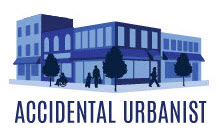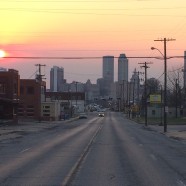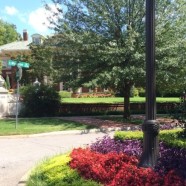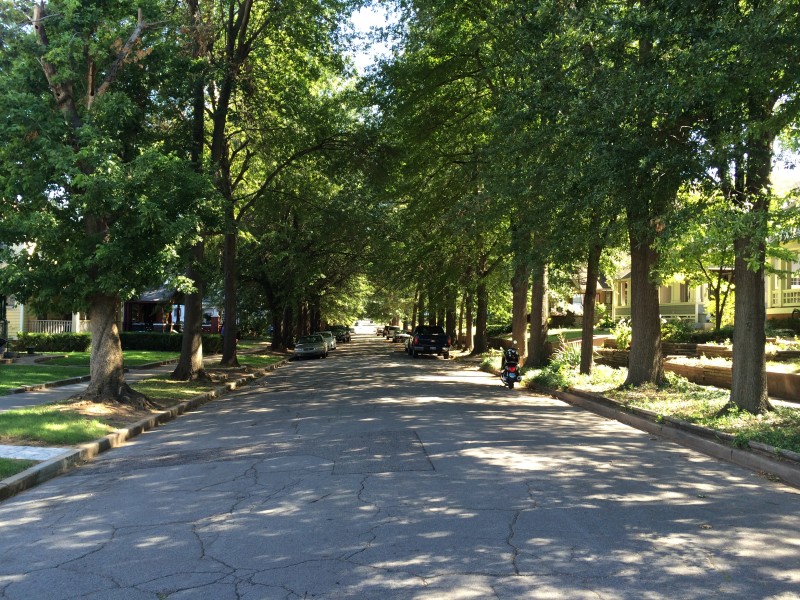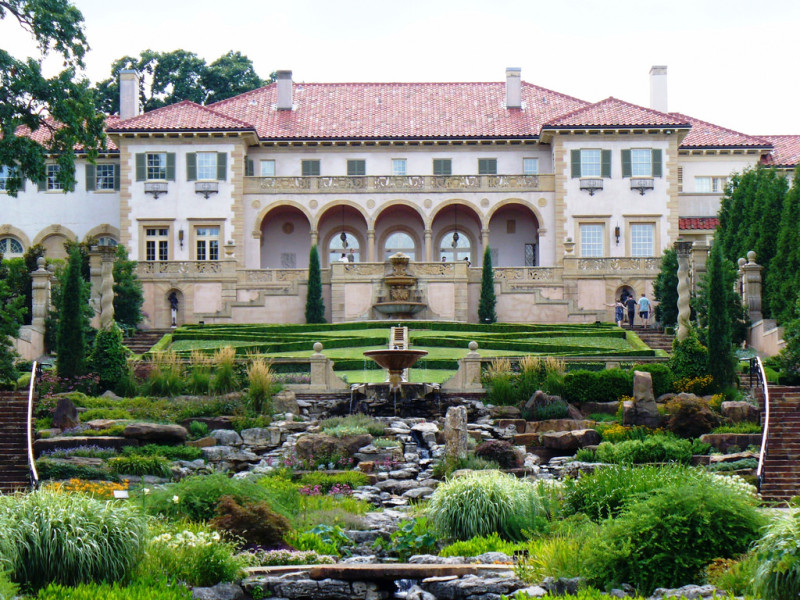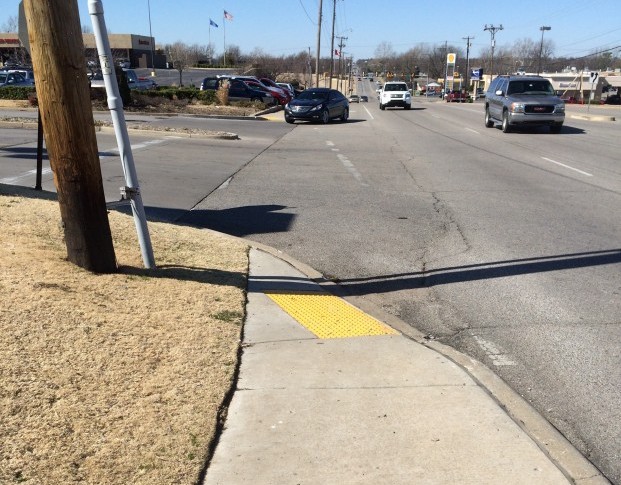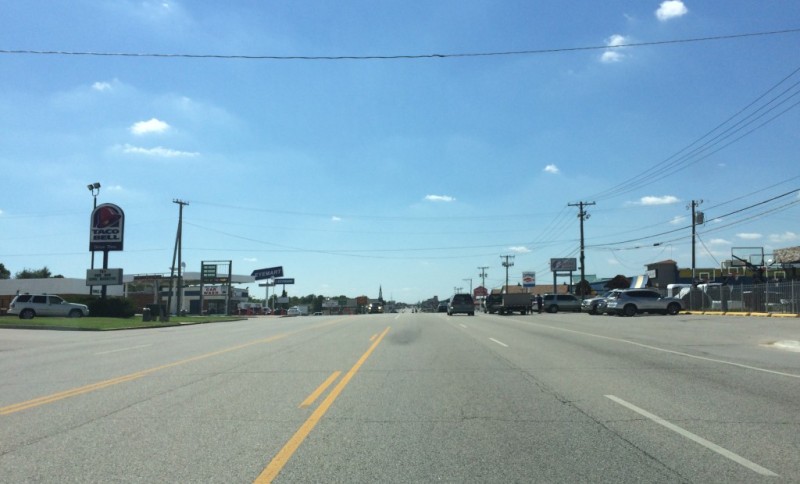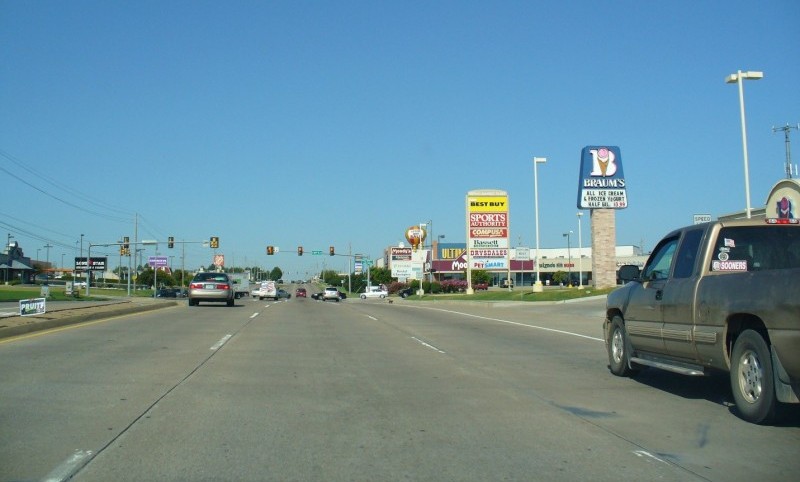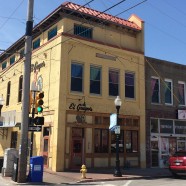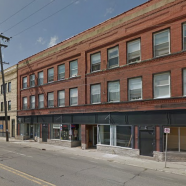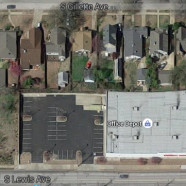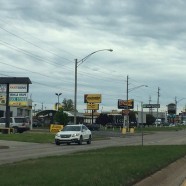Find a Place You Love That Needs You
After years of advocating for walkable neighborhoods and preservation of historic buildings, I decided to stop talking about it, and start doing it. So last year, I took the plunge and purchased a little 1915 bungalow fixer-upper near downtown Tulsa. I thought this would be a good way to learn the financial ropes of small development, build relationships with contractors, and hone my property-management skills before moving up to a small 4-plex or mixed-use building sometime in the future. As it turns out, it’s been all of that, and so much more.
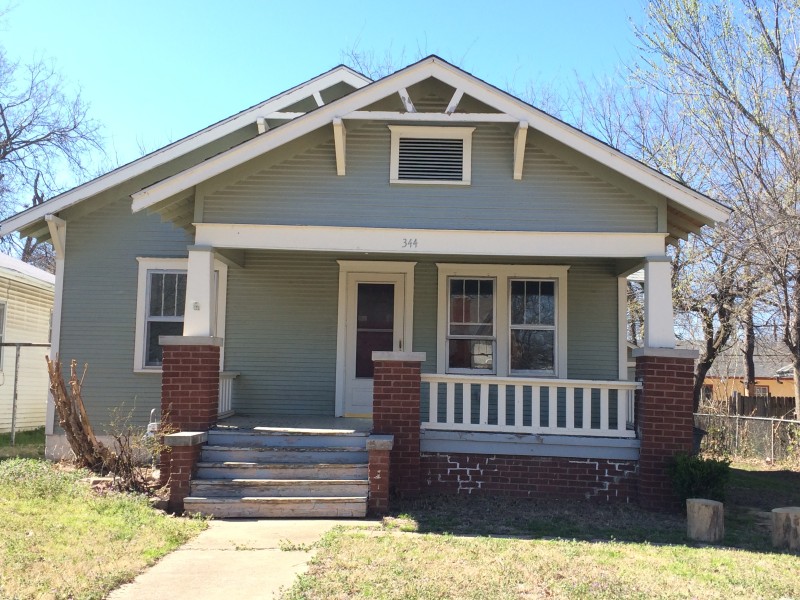
Photo by Sarah Kobos
“Find a place you love that needs you.”
My strategy was to comb older neighborhoods near downtown that need and deserve reinvestment. Basically, I was looking for a place with a compact street grid, alleys, and rundown housing with a couple hipster “indicator species” (brewpubs! yoga!) nearby. So when I saw a house come up in the local sheriff’s auction, I was ready.
Having attended a couple Incremental Development Alliance workshops, I worked up a pro forma based on expected rental income and the cost of improvements, financing, and operating expenses to determine how much I could pay for the house. Then I added about 30% to the renovation budget as a cushion against my own ignorance. The project still “penciled” with room to spare, so I set off to the sheriff’s auction feeling optimistic.
The funny thing is that I didn’t win the auction, but I did get the house.
The only other bidder was a young woman with her daughter by her side. Maybe I was stereotyping, but she looked like so many neighborhood advocates I’ve worked with over the years, it seemed silly to keep bidding against her. We were just making it more expensive for each other. So I stopped a few thousand dollars short of my (very conservative) top price and let her win the auction.
Afterwards, I introduced myself. Within minutes, we bonded over a shared disdain for replacement windows and Home Depot kitchens. She was indeed a preservationist who had renovated several houses in a nearby historic district. Tulsa being Tulsa, we had friends in common. So we exchanged phone numbers, and I left the auction feeling good about the experience, despite “losing” the bid.
A few weeks later, I received a call from her. For various reasons, she and her husband were not going to be able to start renovating the house for several months, and wondered if I would still be interested in it. If so, they would sell the house to me for the price they paid.
Which is how I came to own this little slice of history.
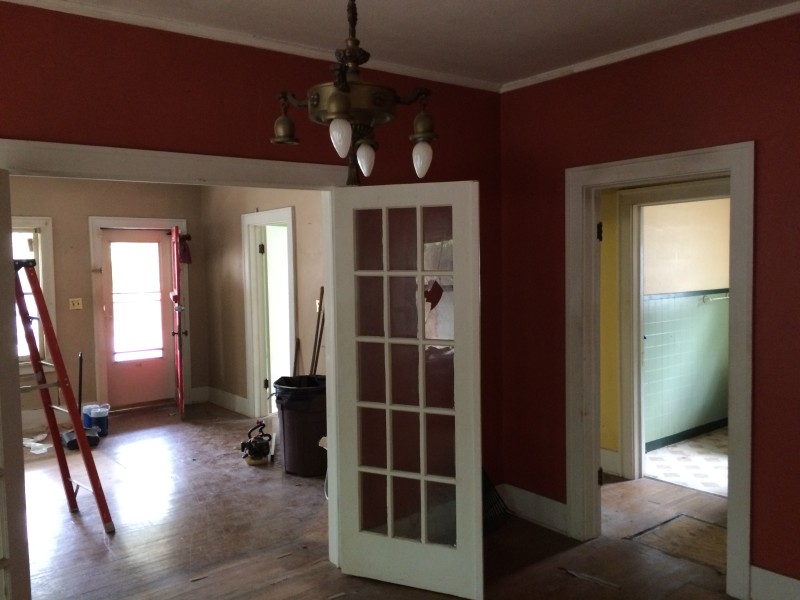
Photo by Sarah Kobos
The house is located on the dodgy end of an up-and-coming neighborhood about a mile east of downtown. Like most “streetcar suburbs” the neighborhood is defined by a compact street grid, houses with front porches on small lots, detached garages, and sidewalks throughout. There are a multitude of classic, if rundown, craftsman bungalows in the area, and everything is conveniently close to a couple historic “main street” districts. Which is to say, the neighborhood has good bones.
It also has pockets of crime and decrepit buildings, thanks to an abundance of slumlords who prey on people with few resources and fewer options.
The house I bought falls smack dab in between the good and the bad. If this street were the Korean Peninsula, my house would be the DMZ. To the south are mostly stable, fairly well-maintained homes with a mix of working-class and retired residents. To the north is slumlord deluxe, with a lot of… shall we say… “entrepreneurial” activities going on.
The house next door has a failing roof, boarded up windows, missing siding, exposed insulation, and an overgrown backyard. I can only assume the landlord is waiting for a good tornado and a sizeable insurance payment before maintenance will begin.
Nearby are a couple rundown 4-plexes, where the owners come by once a week to collect their rent in cash, and remove the front doors when people fail to pay. Door removal appears to be their main skill when it comes to property management. Tenants appear and disappear on a monthly basis, and “friends” come and go with a frequency that implies they’re not there to borrow a cup of sugar.
All this is to say that I’m operating a bit outside my comfort zone. While I’ve done my share of manual labor and blue-collar jobs, I realize that I’m basically a privileged, middle-class, college-educated white woman working in an area where I don’t always understand what’s going on around me. Since I can’t tell a meth addict from a person who lacks dental insurance, my policy is to be polite and respectful to everyone I meet, and hope that folks will return the favor. So far, so good.
Despite all this, I’m excited about the new house. It’s totally intact. Original three-above-one double hung windows with poured glass; original pedestal tub; original doors and fixtures; and oak floors throughout, even in the bathroom and the kitchen. Houses built in 1915 were constructed with lumber from old-growth forests, which means dense, straight wood with unbelievably tight grain. There is simply no way to replicate the quality of materials and craftsmanship that went into the creation of this house.
I remain forever grateful that none of the previous occupants had the desire (or possibly the budget) to ruin it. Had this house been located in a more affluent neighborhood, it would have been gutted. Vinyl windows and particle-board cabinetry from a big box store would have been installed. Light fixtures would have been replaced. Once trendy, now dated, backsplashes would have appeared.
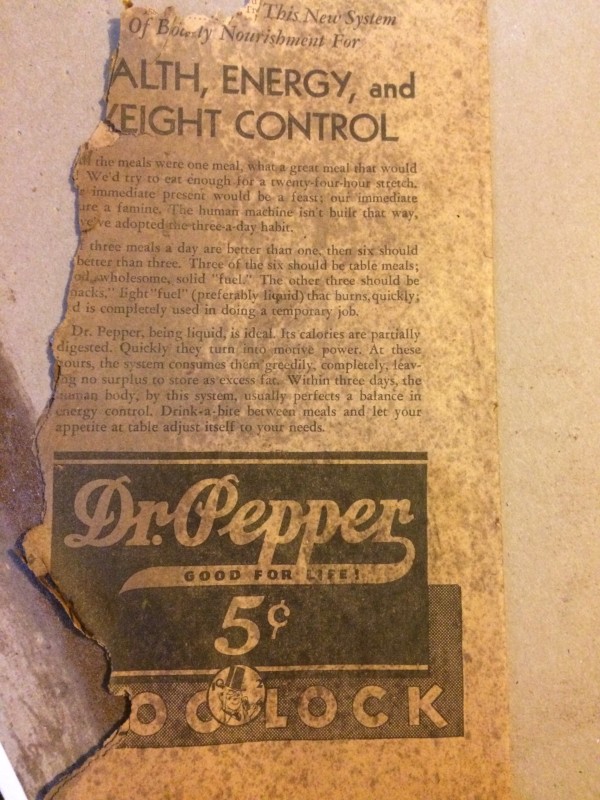
You never know what you’ll find in an old house. – Photo by Sarah Kobos
Old houses and high-quality craftsmanship develop patina over time. They were built to last, and it shows. They age with grace. They can be repaired. My job is to be respectful while I do it.
But there’s more to revitalization than simply fixing up old buildings. A neighborhood is an ecosystem, a quirky human habitat, and when it’s been damaged by generations of neglect, it probably needs help that has nothing to do with repairing roofs and bringing wiring up to code.
The most obvious problems spring from poverty and addiction. From there, it’s an easy spiral down. Folks with few options and a lot of time on their hands are going to get into trouble. Inability to pay lawyers and court fees means more families living on the edge. Criminal records limit job opportunities and housing choices. And concentrated poverty makes it hard to find a way out. When every person you know is in the same lousy circumstances, it’s harder to move up.
In some ways, a little gentrification would be a good thing in this neighborhood. So often people want to work, but there’s no one around to hire them. If I could afford it, I’d hire the whole neighborhood to scrape paint, pour concrete, trim trees and mow lawns. But since I’m living off my savings, I have to do the grunt work myself, and save the paid jobs for licensed professionals.
The whole experience has me thinking about ways to help the people who live nearby. I dream of finding ways to pay people to learn skilled trades. Creating places where you could borrow tools to work on projects or make crafts for sale. Finding ways to help people access the social services they desperately need but may not know are available. Developing policies that would protect people from unhealthy and unsafe slumlord housing and predatory lending.
I don’t have the answers. Right now, I’ve got my hands full just trying to fix up this one old house. Every day I’m humbled…but I’m learning. My project is one small step, and it’s not enough, but it’s a start. It’s just one of a multitude of small actions that will be needed to help make the neighborhood a better place for everyone.
– by Sarah Kobos
(Originally published by Strong Towns on 4/13/17)
Read MoreWhere Every Citizen’s Heart Can Sing
As you go about your day, what do you see?
Are you fortunate enough to live on a tree-lined street, surrounded by charming architecture and manicured yards?
Can you walk to the store along interesting sidewalks where flower beds, public art, and street trees add to the delight of window shopping along your path?
Does your daily life bring you in contact with natural beauty such as oceans, scenic rivers or mountains?
If so, cheers to you.
For most folks, these experiences aren’t part of day-to-day life. They occur only on vacation, where we seek out the most lovable and beautiful destinations during a couple weeks out of the year. Of course, that’s if you’re lucky enough to swing a vacation at all. Many Americans don’t have that luxury. A full 42% of us did not take a single day of vacation in 2014. When a weekend “staycation” is all you get, the quality of your city has a dramatic impact on your quality of life.
A recent jaunt across town has me thinking about what we love (and will travel to experience) versus what we create.
I’ve been thinking about what it means to cut funding for parks to pay for cops and new road construction. What it means when you widen streets, but fail to build sidewalks in neighborhoods where car ownership is a luxury. More than anything, I’ve been pondering the words of Joe Riley, former mayor of Charleston, S.C., and his thoughts on beauty, equality and the public realm:
“Beauty has no economic litmus test. It’s a basic human need and instinct.”
Can anyone dispute that? And yet, for far too many of our citizens, the public realm is defined by crass consumerism and the lowest common denominator of construction materials and techniques.
Like many cities, Tulsa has its gorgeous neighborhoods and grand destinations. Stately mansions built by oil barons, world-class architecture downtown, the gardens at Philbrook Museum, miles of trails along the Arkansas River, and a shining Cesar Pelli-designed arena are among the places that are proudly displayed on postcards and convention bureau publications.
But what about the people who don’t live in historic neighborhoods, or have time to visit art museums, or can’t spare an extra $100 for a concert? What do we build for them?
The vast majority of our public investment in the built environment seems to satisfy only our most pragmatic needs, like patching potholes, widening roads, and updating water/sewer lines—leaving little room for beauty or grace. And while Tulsa is lucky enough to have a “1% for art” ordinance, requiring one percent of all construction costs for public facilities to be dedicated to art, this does not include road projects, where a majority of our tax dollars are spent.
But even with so much of our treasury going to transportation, our streets are not delightful. They are designed for high-speed auto travel, maximum capacity, and the turn-radius of trucks. Our street engineers are not tasked with considering the feelings of “a mother walking down the street, holding her child’s hand”—something that Mayor Riley believes should be the essence of urban design.
Instead we operate in silos. We have vision documents and neighborhood plans showing where people want to see revitalization and walkable “main streets.” We have a zoning map that was never updated to reflect that vision. We have private developers looking to maximize profits, regardless of the adopted long-range plans. And we have city engineers designing city streets to highway standards, which is exactly the opposite of what you need to create the human-scaled, walkable destinations people crave.
When I talk to folks from around the country, I get the feeling that we’re not alone. Getting everybody on the same boat, rowing in the same direction can be a challenge.
Here in Tulsa, I can’t help noticing that we’ve missed the boat in another way. When I think about cities, I’m reminded that the built environment is transformed one project and one building at a time. Over decades, cities evolve and are reborn. To repair past mistakes, it’s necessary to reinvest in older areas, always moving in the direction of a better vision, and a better quality of life for our citizens.
Thanks to an unfortunate state law, however, Tulsa depends almost entirely upon sales taxes for municipal funding. Our craving for “new” tax dollars combined with cheap land has resulted in a misguided 50-year habit of continuous greenfield development. As we have pushed new development further and further towards the south, we have often ignored the vast opportunities for re-development available much closer to the city center.
A WEIRD SORT OF MANIFEST DESTINY
As a result, new developments on the far fringes of the city include improved landscaping, buried utilities and complete sidewalks: everything that would make walking lovely, if only they weren’t designed on a scale suitable only for cars. In older areas, where adjacent neighborhoods have connected street grids and many people walk or use transit, outdated commercial and industrial areas often lack the very amenities that give dignity and beauty to people on foot.
And while we continue to incentivize millions in private investment on the fringes, much of the public realm at the heart of our city suffers. Beautifying and improving existing areas with public funding is difficult. Money’s tight. People who have to dodge potholes on their way to work tend to be less sympathetic to spending precious resources on sidewalks, street trees, benches and planters. And there are always those who argue that “niceties” are not the role of government, and that taxes should only be spent on the bare necessities.
I tend to side with Mayor Riley, who has exactly the opposite view:
“There is no excuse for anything to ever be built that does not add to the beauty of a city. Every investment in beauty yields an economic payoff. If you build beautiful places — whether they are parks, parking garages, or public housing — the land next to these places becomes more successful. They become catalytic agents to generate economic activity.”
If, as Riley says, “the public realm is the part of our city that belongs to all of us, that gives us our identity,” we’re living in a very sad time. Because most of what we build looks like this:
Which brings us back to the folks who won’t get to go on vacation any day soon. During a presentation at CNU in Detroit, Riley reflected on the role of the built environment: “We have citizens who, that’s all they’ve got. They aren’t going to go to Paris or Rome on vacation.” So we should build places where, every day, even the least among us, “can clothe themselves with peace and beauty.”
His comments have stuck with me since that day. It’s the kind of statement you can never un-hear. It’s an idea that soaks into you, and changes the way you look at the world.
What if our goal wasn’t to build the most stuff in the shortest amount of time for the least amount of money? What if, instead, our goal was to create places of lasting beauty where, every day, our souls could be nourished by our surroundings?
What if, instead of volume, we focused on quality? Instead of working to bring new national chains, what if we worked to make every existing block a better place for our citizens? What if we took the millions we spend to widen roads for people with cars, and instead invested that money in making every street a place for all. What if we truly worked to make our city “a place where every citizen’s heart can sing?”
A girl can dream, right?
by Sarah Kobos
Read MoreKey to Education Funding: The Ground Beneath Our Feet
If you care about Tulsa’s future, you care about public education. Having watched in awe as our state legislature convulsed to the end of yet another cringe-worthy session, one thing is certain: education funding is obviously not the top priority of those in control at the capitol.
So what can be done? Let’s talk about what we can achieve at the local level, without ever taking a trip down the turnpike.
If you look at the Tulsa Public Schools budget, you’ll notice that, while state funding is certainly important, TPS actually receives slightly more revenue from local property taxes than we do from the state. In the most recent Budget and Finance Plan for the 2015-16 school year, ad valorem taxes contributed $157,205,576 to total appropriated funds, compared to $155,921,101 from the state.
What this means is that that every residential and commercial property in town generates tax dollars that benefit public schools. The higher the value of the improvements on your land, the more you pay in taxes.
If that makes you cranky, remember this: public investment in roads, water lines, sewer systems, police, fire fighters, and an educated workforce give value to your private land. Public investments act like fertilizer that allow private development to grow and prosper. In return, private entities are taxed on the value of their property to help fund critical community needs like public education, technical training, libraries, the Tulsa County Health Department, and county government.
This is the handshake of community: everyone contributes and everyone benefits.
Each year, when you pay your property taxes, you are investing in the success of Tulsa and its citizens. You’re either paying it forward, or paying it back. Either way, cheers to you!
But back to our underfunded public schools, and the grim realization that a 4-day school week is not outside the realm of possibility in our near future.
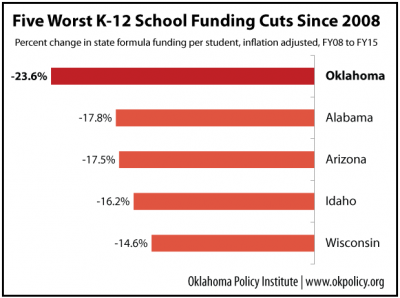
There’s Reason for Hope
Despite this shocking statement, I remain optimistic about the future of education funding. Tulsa has an ace up its sleeve that we’ve ignored for more than half a century, and it’s time we played that card. I’m talking about the land on which our city is built, and the fact that we have not come close to maximizing its value. (Don’t worry: I am NOT talking about turning park land into shopping centers!)
For clarification, let’s pay a visit to El Guapo’s Cantina.
In case you don’t know, El Guapo’s is one of several homegrown hits created by local restauranteur Elliot Nelson and The McNellie’s Group. It’s a Mexican restaurant that contributed to the rebirth of downtown Tulsa while celebrating Taco Tuesdays, rooftop dining, and surprisingly potent margaritas. They have two locations: the original one downtown, and a new south Tulsa restaurant at 81st and Harvard.
As it turns out, these two locations can teach us a lot about Tulsa Public Schools’ bottom line.
Doing the Math
First, we have El Guapo’s downtown, located on the southwest corner of 1st and Elgin. Built in 1912, this building occupies a typical 25 x 100 downtown lot, filling the entire 2,500 square foot parcel with a two-story building and a cool rooftop patio. According to the tax assessor’s website, the building contains 5,000 square feet of air conditioned space and pays annual property taxes of about $12,029. This means that every square foot of land associated with this modest building generates $4.81 in property taxes per year.
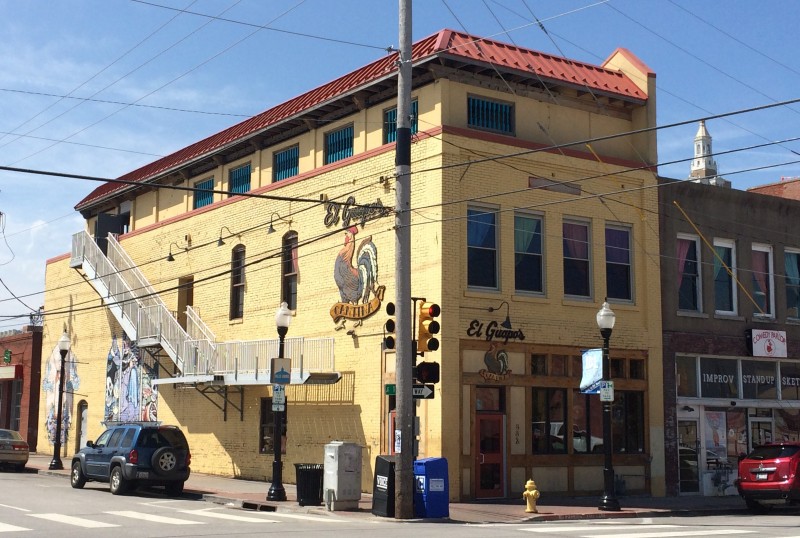
El Guapo’s downtown location – built in 1912
Next, we have the south Tulsa location near the southeast corner of 81st and Harvard. Built in 1979, this single-story building occupies 10,487 square feet of its 75,039 square-foot parcel. The remaining space (64,552 square feet) is dedicated to parking and landscaping. The entire parcel generates $15,899 in property tax revenue each year, which equals about $0.21 per square foot of land.
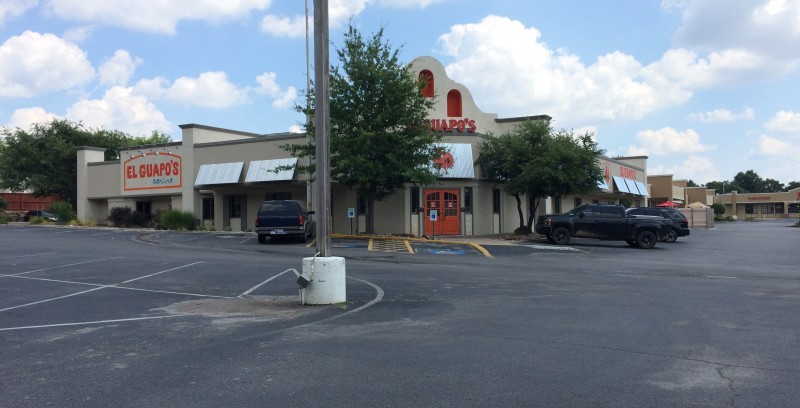
El Guapo’s south Tulsa location – built in 1979
To put this in perspective, El Guapo’s downtown generates approximately 23 times the amount of property taxes per square foot of land than the one located in a highly desirable south Tulsa location.
Have I got your attention yet? Educators… are you doing the math?
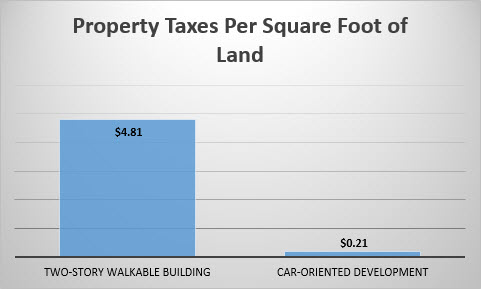
Sure, some of the difference is based on the relative value of downtown land, which can add a 40% premium over a similar parcel in the burbs. But that doesn’t explain the more than 2,000% premium on ad valorem taxes that we’re getting at the original El Guapo’s.
What really matters is how efficiently we’re using that space.
Walkable Places Generate More Taxes
Back in the day, people walked—and cities were built to accommodate this basic form of transportation. Blocks were smaller and parcels tended to be long and narrow, which allowed you to fit a lot of storefronts along a single block. Multi-story buildings were built up to the sidewalk, with doors and windows facing the street. All of this made it incredibly easy to walk from place to place, and people could live, work and shop within a compact area.
This development pattern was not only great for pedestrians; it was great for the city. The efficient use of land meant that it generated far more tax dollars than it cost to support. Tax revenue from these compact, multi-story buildings easily paid for the associated public services and infrastructure: roads, water, sewer, stormwater, police, fire, and—yes—schools.
Development patterns changed after World War II, when a combination of government policies (everything from local zoning codes to federal mortgage insurance regulations) incentivized suburban growth, while making old-fashioned, walkable places nearly impossible to build.
As the city spread out, zoning prevented us from mixing residential and commercial uses. People lived far from where they shopped and worked, driving became a necessity, and parking lots became the primary architectural feature of our city.
Too Much Parking Dilutes Revenues
Take another look at the two parcels our restaurants occupy. I’ve superimposed the downtown building onto the suburban shopping center to make it easy to visualize. (Scale is the same.)
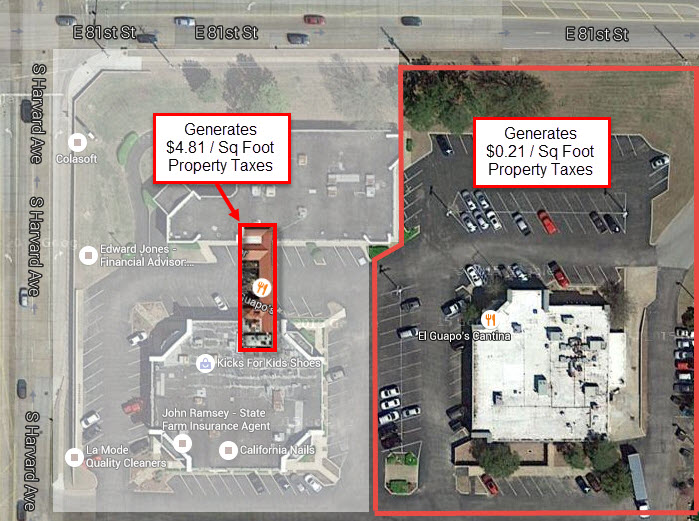
Comparison of traditional commercial building to modern shopping center.
El Guapo’s south includes dedicated parking for about 100 cars. El Guapo’s downtown includes space for zero. Amazingly, the downtown building is little more than one car-length wide. In fact, if the building were a parking lot, it could hold eleven cars.
I’ll let that soak in for a moment. Eleven cars.
In downtown Tulsa, there are no requirements to provide dedicated off-street parking. Instead, customers who drive rely upon hundreds of available parallel-parking spaces, nearby parking garages and shared parking lots. A growing population of downtown residents walk to dinner, and more and more people are choosing to bike. The building is also located close to several transit routes. This is a much more efficient system that allows people to choose their mode of transportation. At the same time, the market determines how much parking is needed, and includes the flexibility to allow spaces to be utilized both night and day by different users.
In the suburban model, every “use” provides its own dedicated off-street parking. Major streets are designed for fast moving vehicles, which doesn’t allow for on-street parking. And the buildings themselves are designed to be accessed solely by automobile. They are built on huge parcels of land, pushed back away from the street, and separated from the sidewalk by expansive parking lots.
This is great if you want to drive, but unfortunately, this single-purpose design limits our ability to utilize modes of transportation that would allow us to maximize the value of our land—and, thus, our tax revenues.
If You Care About Education Funding, You Should Care About Walkable Places
Because El Guapo’s downtown has two floors and a rooftop balcony, it functions as a 3-story building. It essentially occupies 300% of the land it sits on. Because the suburban site is a single-story building surrounded by parking, it occupies 14% of the available land. This makes a big difference to the tax assessor.
Which is why it should matter to you.
If you live in the Tulsa Public School district, about 50% of your property taxes go to support your local K-12 schools. Thus, if we want to raise an additional $50 million dollars for Tulsa Public Schools through ad valorem taxes, we would need to add about $100 million in taxable value to the land within our school district’s boundaries.
As shown above, the car-centric model of commercial development yields about $0.21 of property taxes per square foot of land, while an old-fashioned, walkable, two-story building generates about $4.81 per square foot. If we continue building our city like we did at 81st and Harvard, it would take 17 square miles of new development to increase our TPS budget by $50 million. However, it would only take ¾ of a square mile of dense, traditional, walkable buildings to achieve the same $50 million increase. (And that’s only considering 2-story buildings. Now imagine the multiplier if we built 3-story buildings!)
Think about that. Everyone can picture a square mile, because Tulsa is laid out on a grid. For example, 17 square miles would cover everything from 11th to 51st and Peoria to Sheridan, plus one more square mile thrown in for good measure. By contrast, three quarters of a square mile can be envisioned as 4th to 11th and Peoria to Delaware Ave.
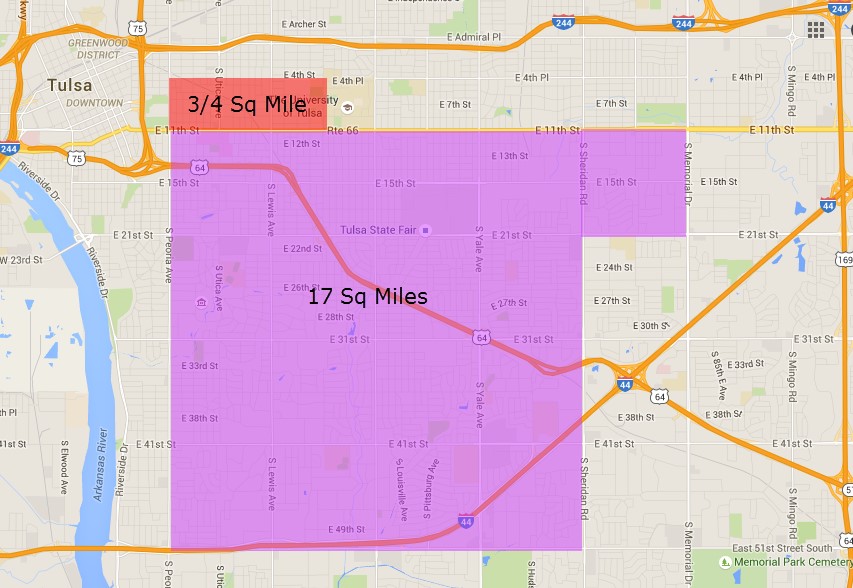
The amount of new land required to add $50 million to the education budget. Red shows traditional, walkable development. Purple shows car-oriented development.
Which option seems more realistic?
If you add up all the empty lots and under-utilized parcels of land in Tulsa, it’s easy to envision adding ¾ of a square mile of old-fashioned, high-quality, walkable infill throughout our city. Adding 17 square miles of car-centric development? Not so much.
We Need More Walkable, Bikeable, Transit-Friendly Places
If we want to solve our education budget crisis, the answer doesn’t lie solely in Oklahoma City. In fact, it’s right here in Tulsa, literally at our feet.
Building places that are conducive for walking, biking and transit is not just a good idea because people love them. It’s a moral imperative. Too much asphalt dilutes the value of land, and puts our schools in the red. A return to the traditional development patterns of the past will be the key to Tulsa’s future.
Some Good Things Are Already Happening.
For the first time in decades, Tulsa’s updated zoning code allows the possibility to create traditional, mixed-use, walkable places. In approving the recent Vision initiative, voters also supported a dedicated source of funding for transit. There’s also growing support for protected bike lanes and improved pedestrian infrastructure, along with a surge in ride share programs like Uber and Lyft. All of these are critical elements that will allow Tulsa to grow and increase our tax base without the downside of inefficient, car-centric development patterns.
But the status quo is a powerful force that will continue building wasteful sprawl unless we fight for change.
So whenever you see a vast, underutilized parking lot, you are looking at Tulsa’s future. Either we will continue to squander this land and the chance to fully fund public education, or we will return to our traditional roots, and build places that are great for people–and our schools’ bottom line.
by Sarah Kobos
Read MoreParking Vs. The Walkable Building (The Developer’s Dilemma)
John Anderson (R John the Bad, if you read his blog) is a guy who spent years trying to convince developers to care about walkable urbanism. As it turns out, the “brain damage” wasn’t worth it. A better approach, he decided, was to teach urbanists how to be developers. Which is how I met him last summer at the Congress for New Urbanism’s “Rookie Developers Breakfast.”
I wasn’t the only wannabe who showed up. Overwhelming interest in the topic inspired the creation of a Facebook group called Small Developer / Builders and a series of “Small Developer Boot Camps” led by John, Monte Anderson, and other members of the Incremental Development Alliance.
The lessons they teach would make Jane Jacobs dance on the sidewalk. Start small, keep it simple, build incrementally, foster local tradesmen, provide places for entrepreneurs, take the long view, invest in your neighborhood, and improve it one building at a time.
With each project, you enrich the soil of your “farm,” making the entire area more desirable and livable for you and all your neighbors. Monte Anderson, who has worked this sort of magic in his hometown of Duncanville, TX, calls it “gentle-fication,” a process that brings the community up with you in a gradual and sustainable way.
If you’re a regular Strong Towns reader, this probably makes a lot of sense. After all, this is how cities were traditionally built. People invested in the communities where they lived. Owner-occupants made incremental improvements with the expectation that their legacy would provide lasting value over time. It was never about making hedge fund investors rich from 3rd quarter profits of commodified real estate packages.
This return to an old-fashioned ideal is one of the things that makes small-scale development so appealing—especially to folks like me who care about good urban form, walkable places, and revitalizing neighborhoods. With low overhead and smart choices, it’s actually possible to build desirable places that normal people can afford. These projects help provide crucial “missing middle housing” that the big developers with their high overhead costs simply can’t deliver.
As John Anderson likes to say, “If you’ve ever found yourself eyeing an empty lot and thinking ‘Somebody ought to…’ Well, maybe that someone is you.”
IMPORTANT LESSONS FOR THE SMALL-SCALE DEVELOPER
But there are a couple important lessons that every starry-eyed dreamer/developer must consider.
First and foremost: if you can’t get the rent, you can’t build the building. So when calculating whether or not a project will “pencil,” you start with average rents and construction costs for your area, and work your way backwards to see what’s feasible. Everyone has sexy dreams, but as a developer it’s important to maintain a long-term, monogamous relationship with math.
The second lesson? “Keep it simple.” This encompasses everything from using commonly available construction materials to taking advantage of FHA loans. It also applies to site selection: whenever possible, you want to build “by right” on land that is already zoned for what you want to do.
Unfortunately, this is where a terrific aphorism crashes headfirst into the painful rock face of reality. Because most local zoning codes are ideally suited to building car-oriented crap, they are perfect for folks who like to transform large parcels of land into parking lots, shopping centers, and chain restaurants with drive thrus. Far too often, they conflict with the type of small-scale, walkable places our ancestors would recognize as home.
In cities throughout America, the places we love the best are often illegal to build. If you don’t believe me, test out your hometown zoning code by “building” a project on paper.
KICKING THE TIRES OF YOUR LOCAL ZONING CODE
That’s exactly what we did at a recent Small Developers Boot Camp in Bentonville, AR. We were given a portfolio of development opportunities taken from real life in Kalamazoo, MI. Our package included descriptions of various lots with prices based on comps; a market study of rental rates for commercial and residential spaces; average construction costs per SF; the current zoning for each parcel; and a “plain English” summary of the applicable zoning code requirements. Thus, we were able to compare lots while taking into account market realities and the nitty-gritty zoning requirements that can make or break a deal.
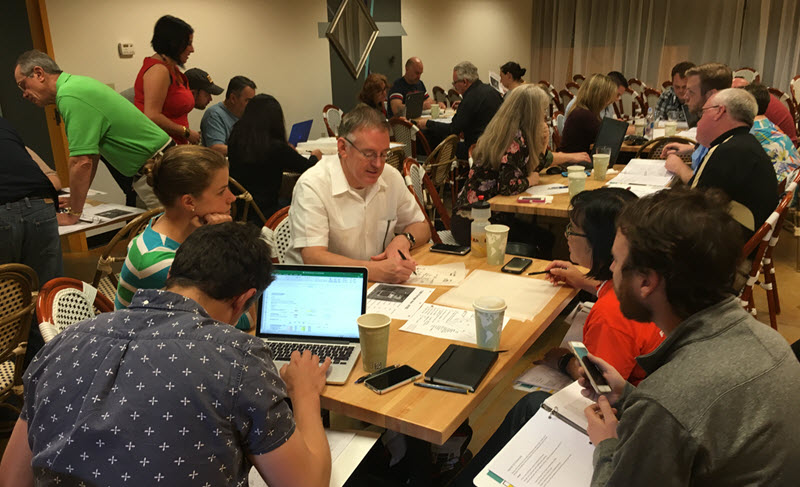 Our mission: Decide what we wanted to build, pick an appropriate lot where we could build it by right with current zoning, and use a pro forma to check the math and see if the project makes money.
Our mission: Decide what we wanted to build, pick an appropriate lot where we could build it by right with current zoning, and use a pro forma to check the math and see if the project makes money.
As aspiring small developers, we first looked for affordable, modest-sized lots, where adding a single building would help complete a missing piece of the neighborhood puzzle. This allowed us to quickly reject big, expensive parcels that were beyond our means.
A glance at the zoning code helped us dismiss other locations.
We wanted the option to build residential over commercial, but this was not allowed in several of the purely residential zoning districts. Minimum Lot Area Per Dwelling Unit (basically, how much land you need per residential unit) and setback requirements (how far back from a lot line you have to build) further limited our choices.
THE DEVIL IS IN THE DETAILS. IT’S ALSO IN TABLE 4.1-A OF YOUR LOCAL ZONING CODE
I have to say, the Minimum Lot Area requirements surprised me the most. We envisioned a compact, mixed-use building with up to three stories and six dwelling units combined with ground-floor retail. But even in a traditional neighborhood where the existing building stock matched our vision, we were limited to three residential units because of this arbitrary restriction.
We would have loved having those extra units, and I’m sure Kalamazoo would have appreciated the extra property taxes our ideal project could have generated—but the code said “no!” (Take that, local schools!)
Ultimately, we decided to test a two-story, mixed-use building with residential above retail, just like the adjacent older buildings, but smaller. For the purpose of our quick estimate, we assumed we would build three 800 SF residential units above 2,400 SF of commercial space on the ground floor, which could be divided into two or three separate storefronts if desired. It wouldn’t maximize use of the space, but it would fill in a “missing tooth” on what was once a lively, walkable street.
PARKING V. BUILDING
Next came off-street parking requirements–and the audible groans and outcries of our merry band of aspiring developers. The parcel we selected was zoned “Commercial Neighborhood” which included a lovely statement of intent: “to promote pedestrian-oriented development” and“encourage small-scale retail sales and personal services to primarily serve nearby residential neighborhoods.”
Of course, nothing says “pedestrian-oriented development” like a vast amount of off-street parking!
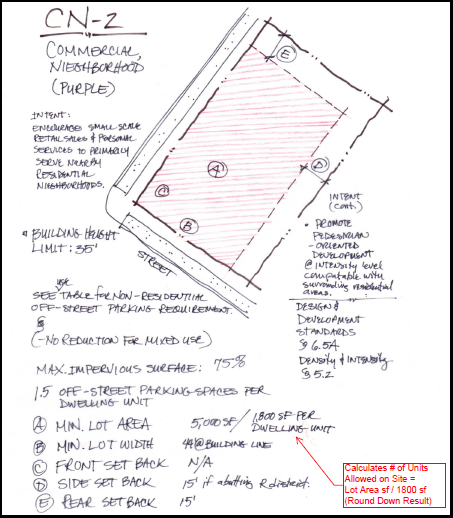 “Let’s make car storage the primary function of our city!” exclaims absolutely no one ever. Unfortunately, the zoning code does. Which is why most cities say they want walkability, but require a ridiculous amount of off-street parking.
“Let’s make car storage the primary function of our city!” exclaims absolutely no one ever. Unfortunately, the zoning code does. Which is why most cities say they want walkability, but require a ridiculous amount of off-street parking.
In our case, each one-bedroom unit required 1.5 off-street parking spaces. Thus, our three apartments needed five total parking spaces (of course, you have to round up). The commercial parking requirements were even worse. It was a moving target based on “use.” Would the commercial space be used as offices? Retail? A coffee shop, restaurant or bar? How could we even know? (None of us brought a Magic 8 Ball to the workshop.)
DOING THE MATH…
The commercial off-street parking requirements ranged from one space per 330 square feet of office floor area to one space per 100 square feet of restaurant. At a minimum, we would be required to provide 7 parking spaces for our 2,400 SF of commercial space. If a tenant wanted to use this space for a bar, we would need 24 parking spaces—because drinking and driving is oddly enshrined in most zoning codes.
All together (calculating residential and commercial) we would need parking for 11 to 29 cars for our little building. And since it takes about 300 SF of land for every parking space (which includes the stall plus associated drive aisles) we would need between 3,300 and 8,700 square feet of land dedicated solely to parking.
Did I mention that our parcel was only 6,752 SF? And we wanted to include a building?
After a lot of sketching and scratching of heads, we managed to fit our building and 10 parking spaces on the lot. Close, but no cigar in our attempt to fulfill the requirements of the zoning code and build “by right.” In real life, that single space we lacked would require a trip to the Board of Adjustment to beg for a variance.
I’LL TAKE PARKING FOR 100, ALEX…
Our story is not unique. Throughout the country, you’ll find zoning codes quite similar to those in Kalamazoo. Because it’s expensive and tedious to overhaul zoning ordinances, they tend to fossilize over time. Unfortunately, many of them appear to be trapped in a geologic formation that includes beehive hairdos, transistor radios, and the 22-volume 1971 World Book Encyclopedia.
Thus, zoning ordinances still require off-street parking to “lessen congestion in the public streets” as if promoting auto travel is a scientifically proven method for eliminating traffic. And while some cities are beginning to reduce off-street parking ratios, only a brave minority have taken the plunge to eliminate them altogether.
So even if those parking spots aren’t needed, they are required. Which basically sucks for everyone except the guy who lays the asphalt. It limits the ability of developers to build small-scale infill projects that contribute to walkable neighborhoods. It incentivizes driving, while punishing people who walk, bike and use transit. And it dilutes property tax revenues because asphalt is never the highest and best use of land.
You’d think this problem would be easy to fix. But if you’ve ever doubted that the pen is mightier than the sword, just try to change a few words in your local zoning code. People will show up in force to protect the status quo as if defending against a zombie apocalypse.
Which is funny, because most folks don’t have a clue what the zoning code actually says or how it impacts their daily lives.
Reading your local zoning ordinance is a powerful soporific; it will induce sleep faster than a Benadryl with bourbon. But it is also, literally, the law of the land—a regulatory document that determines how buildings, neighborhoods and cities will evolve over the coming decades.
If you care about your city’s future, you care about the zoning code.
If we want that future to include small-scale, incremental development that creates walkable places, while building local wealth and improving traditional neighborhoods, we need to make sure our zoning codes enable that vision.
It might be time for a review. Grab a coffee and a copy of your zoning code, and get busy!
Read MoreBell Bottoms, 8-Track Players, Parking Minimums…
Zoning is a funny thing. It’s the invisible hand that sculpts our cities. It’s the rulebook that governs private development—dictating what and where and how things are built. All too often, it’s the arrogant czar who proclaims “Nyet!” when a developer wants to build a place for people and pedestrians. Simply put, zoning has the power to make or break a place. But the topic is so boring, nobody wants to think about it.
Yet zoning—that dry, humorless, sleep-inducing code—is essential to the health of a city and the people who call it home.
If you’ve ever wondered why you can’t walk to the places you need to go, why parking lots have become the dominant architectural feature of our cities, or why there isn’t a coffee shop or a bakery in your neighborhood—congratulations! You’ve just discovered zoning!
Hopefully, Change Is on the Way
Tulsa is currently performing a comprehensive update of its zoning code for the first time since 1970. Like bell-bottom pants, pet rocks, and 8-track tape players, our zoning code should have been shelved decades ago. Instead it’s been dutifully chugging along: prioritizing automobile travel over every other option, punishing pedestrians and transit users, and turning our city into a giant parking lot.
Hopefully, change is on the way.
If you’re happy with the status quo, let’s see if a quick example can change your mind.
Take a look at the Office Depot at the corner of 15th and Lewis, which was built in 2004 on the site of an old grocery store.
In the current zoning code, this is considered “Shopping Goods and Services,” and the super-scientific-sounding code calls for 1 parking space per 225 square feet of building. Since the Office Depot building occupies 22,264 square feet, our zoning code (perhaps imagining a desperate run on staplers and toner cartridges) requires 99 parking spaces.
Here’s what that looks like:
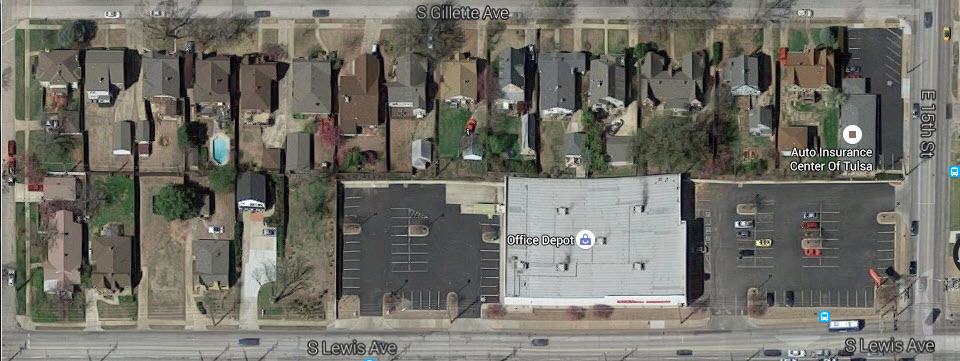
Although the building appears to front Lewis Avenue, it actually “faces” 15th Street (with a deep setback and parking in front). The front parking lot (to the right of the building) provides for 57 spaces, while the rear parking lot (shown to the left) contains 38. (Presumably, the developer received a variance to provide 95 spaces, instead of the 99 dictated by the zoning code.)
Important note: No one in the history of parking has ever actually parked behind this store.
In the proposed update to the zoning code, this location in the historic Gillette neighborhood would be considered “urban” and would receive a reduction in the amount of required parking. The proposed zoning code would require 1 space / 300 SF of building, equaling 74 required parking spaces.
The amount of land that could have been saved by the proposed new code is shown in red below.
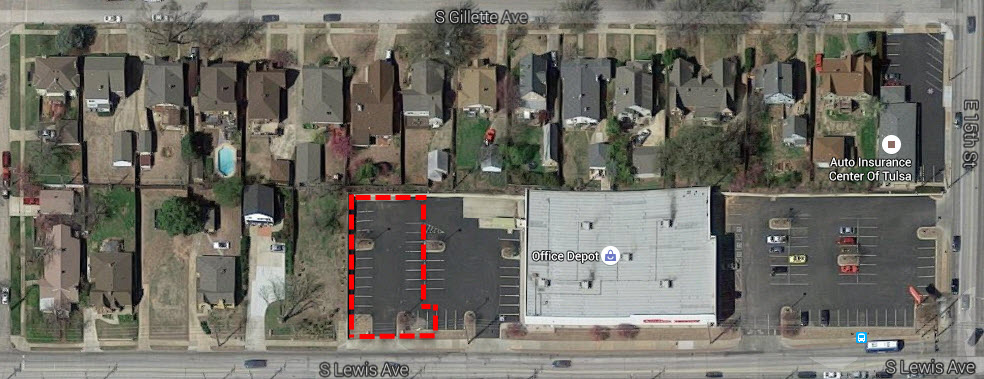
Had the proposed zoning been in place years ago, it could have prevented the demolition of a historic home without impacting the success of the store.
Bad Zoning Costs Money
Why do you care? Because each 7,275 SF lot that was converted to surface parking for this store currently generates about $1,587 in property taxes. Compare this to the remaining homes along Lewis Avenue which generate, on average, $2,626 in property taxes per lot.
By NOT destroying one home for parking that nobody will ever use, Tulsans would have received 65% more in property taxes from that land than they do today.
That’s money that could have been funding public schools, community college, vo-tech, libraries… basically making the city a better place to live.
Or you could have a bunch of asphalt that nobody uses.
Excess parking also adds to the cost of retail space because developers must purchase more land than they actually need. Those costs are folded into the price of commercial leases, which are passed on to you, the consumer. Whether you drive to the store or not, you pay for the “free” parking with every purchase.
It’s Time for a Change
Here’s a better idea. What if we simply eliminated parking minimums from the zoning code? What if we let private land owners determine how many parking spaces were needed for any given development?
This wouldn’t eliminate parking, it would simply give developers the right to decide for themselves how much parking they really need.
(Telling an office supply store how much parking to provide is like telling them how much paper to stock on their shelves. It’s not a job that city planners are qualified to perform.)
Plus, in the age of Amazon Prime and online shopping, excessive parking requirements create a competitive disadvantage for brick and mortar stores. Every parking space adds to the cost of overhead. Meanwhile—in an ironic twist—the need for off-street parking is probably already decreasing due to the increase in online sales.
Without arbitrary parking minimums, the property owner would be incentivized to make the best use of the land. They might determine that 38 parking spaces are more than adequate for their parking needs—especially since the development is directly adjacent to a transit stop in a traditional, walkable neighborhood. (Bonus points if you noticed the bus stopped at the corner of 15th and Lewis in the pictures above.)
A wise developer would encourage transit use, cycling and walking because conserving land—wasting less land on unnecessary parking—means lower costs and/or more space available for buildings that actually generate income.
Small Changes Make a Big Difference
So, what’s an easy way to encourage walking, biking and transit for little or no cost? It’s pretty simple, really.
Bring the front of the building up to the street, making it convenient and safe for pedestrians to access the front door from the sidewalk. Plant trees along the sidewalk to make walking more pleasant and dignified. Create some window displays for people to look at as they walk by. Suddenly, you’re sending a new message: “This is a place for people!”
What would that look like? Just imagine…
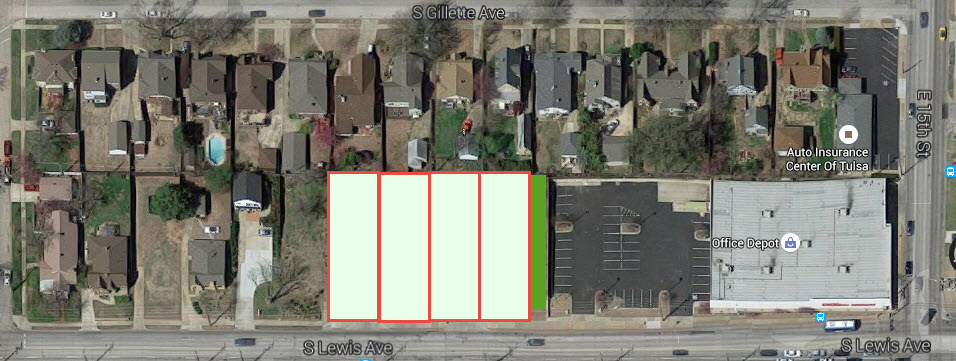
By eliminating parking minimums and bringing the building up to the corner where it belongs, we just preserved FOUR historic homes (increasing the tax base by 65% on each lot), while maintaining an ample supply of off-street parking for the store. There’s even space for a generous landscaping buffer between the parking lot and the residential uses. We’ve also increased the visibility of the commercial building by locating it at the corner of a busy intersection.
All of this can be achieved while making the city a better place for people.
It can be done through zoning.
Which maybe isn’t so boring after all.
Read MorePriorities
Give this a try. Ask someone what’s most important in life. Then listen to their response.
Most likely, they will talk about the people they love. They will mention their spouses, their kids, their parents, their friends and their neighbors. Many will focus on their role as providers or caretakers. They may talk about their jobs, their faith, or their health. Or, you’ll learn about their passion for art, or gardening, or the local sports team. Others will talk about community: their favorite charities, the problems they want to solve, or the people who have made a difference in their lives.
You can quickly see a trend. Our priorities tend to center around family, community, connection, health, purpose, and joy.
With that thought in mind, take a fresh look at the city you call home.
Unless you’re lucky enough to live in a historic neighborhood or a traditional downtown, you’ll quickly see a disconnect between our values and the way we build our cities and towns.
That’s because–for the past 60 years or so–we have failed to design our environment for the people we love. We have failed to prioritize family, community, connection, health, purpose and joy. Instead, we have focused almost entirely on the movement and storage of cars.
Don’t believe me? Look around. What are the defining characteristics of the city you call home?
Wide streets, giant parking lots, enormous signs, and huge buildings dominate the typical suburban landscape. They dwarf us.
Future archaeologists will scratch their heads in wonder, puzzling over what strange species called this place home. The greatest scientific minds will excavate our cities and determine that the average human was 17 feet long, 6 feet wide, 5 feet tall, and traveled at speeds between 45 and 80 MPH. They will conjecture about the strange religious customs that required us to segregate our activities–preventing us from working or shopping in the vicinity where we lived or raised our young. They will marvel at our ability to construct concrete edifices, but wonder about the geo-political threats that must have caused us to disperse so widely across our territory.
What else could explain this ridiculous thing we’ve created?
We have dedicated millions of acres of land to asphalt. In doing so, we’ve created places where it’s not safe, much less desirable, to walk. Instead of bringing people together, we have created barriers. Sadly, we have created places where you need a car to cross the street.
We seem to care more about cars than ourselves. We have robbed ourselves of the pleasure of physical activity. (Would you rather drive to the gym, or walk to dinner?) Meanwhile, we have engineered an epidemic of obesity and chronic disease by making it impossible to get from place to place on foot.
In doing so, we have robbed our children and our elders of their ability to live independently. Instead of enjoying a purposeful, connected life, those who can’t drive become prisoners in their own homes. Unable to work, socialize or shop without driving, many become isolated and disengaged from their communities.
Meanwhile, the ever-increasing cost of maintaining roads and providing police and fire services to far-flung areas depletes municipal budgets. The parks budget is inevitably the first thing cut. Again, we provide for automotive travel, but not safe, enriching places where our children can run and play and make new friends.
We have systematically engineered the least efficient, least sustainable, least logical, and most expensive transportation system imaginable—and then designed our homes, businesses, schools, churches and parks to support that design.
We’ve made a mistake.
It’s time we started thinking about this. It’s time we started asking questions and demanding more.
We can fix it, but it won’t easy to overcome the powerful inertia of the status quo. It’s going to take knowledge and passion and dedication. It’s going to take a lot of people engaging in the process of shaping their communities.
It’s taken us 60 years to get to this point, so transformation won’t happen overnight. But we’ve got to start somewhere. So why not here? Why not now?
It’s time.
Read More